Click on the top “Tencent Technology“, “star or pin the public account”
At critical moments, we deliver information promptly.

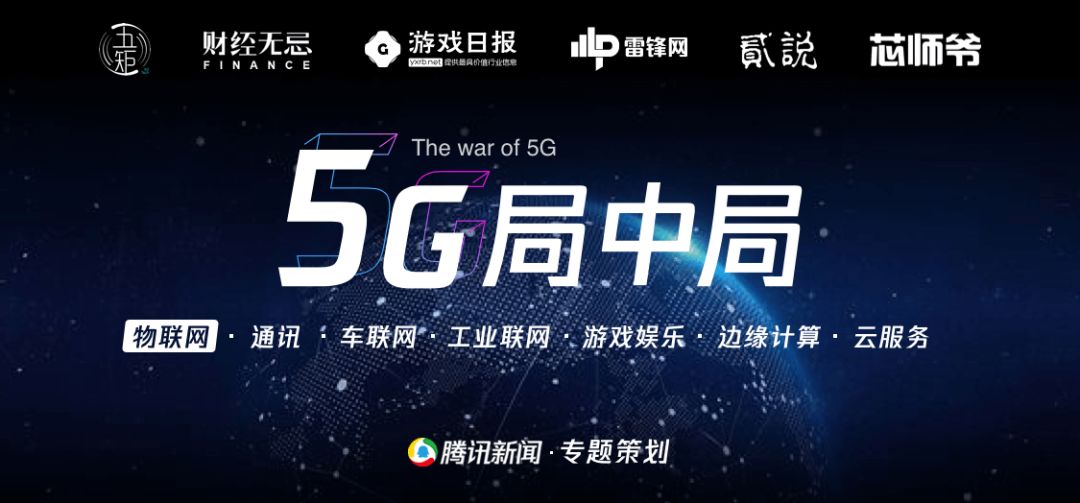
Source / Wuju (ID: kejiwuju)
Author / Shitou
Welcome to download the Tencent News client, follow the technology page to see more technology hot news.
Editor’s Note:
The 5G era has arrived, and the pace of 5G commercialization is gradually accelerating. Tencent Technology, in collaboration with quality technology partners, has launched the “5G In-Depth” series of articles to interpret the applications of 5G in communications, the Internet of Things, vehicle networking, industrial networking, edge computing, cloud services, and other industries, deeply analyzing how 5G technology will impact the competitive landscape of industries.
Today’s article focuses on the Internet of Things, mainly discussing why the Internet of Things will explode in the 5G era and the stories behind the supply chain after this explosion.
The author of this article is Wuju, an industry observation media focusing on communications, AI, the Internet of Things, and cloud services, providing in-depth interpretations of real-time hot topics based on global communication industry technology dynamics.
“Before you return home, you can use a mobile app to turn on the air conditioning and TV in your home in advance, and during your workday, you can further control the opening and closing of the balcony curtains with your phone, allowing the plants at home to grow in a healthier way.”
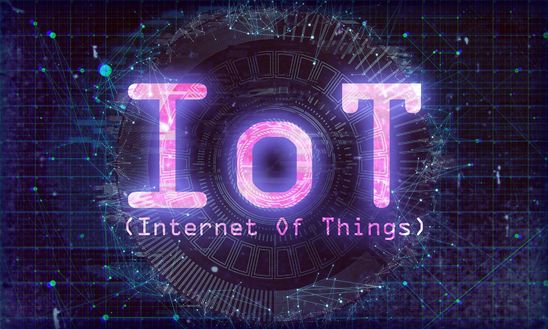
This seemingly sci-fi scene has become a reality today with the construction of “smart home” scenarios by various technology giants. Even in a humorous take on humanity, some speakers equipped with artificial voice assistants can occasionally engage in seemingly clever interactions due to “reflex actions.”
In fact, as early as 2015, with Apple providing the HomeKit SDK, users were allowed to control locks, lights, thermostats, cameras, and switches using Apple products. Additionally, in 2014, Google spent $3.2 billion to acquire the smart connected thermostat manufacturer Nest, indicating that local IoT technology had matured.
But why, three years later, do we still perceive the Internet of Things (IoT) as merely a presentation on PPT? Why is the construction of smart homes still just a toy for a very few people around us?
As the 4G era comes to a close, what explosive reaction will the layout of the Internet of Things have with 5G? What role do cloud computing and artificial intelligence play in the Internet of Things?

The Internet of Things in the 5G Era Will Be an Ecological Battle
On Zhihu, a user wrote: The Internet of Things is to artificial intelligence what the nervous system is to the brain; without the support of the nervous system, the brain cannot perceive everything, and artificial intelligence will continue to develop in the form of “artificial stupidity.”
Therefore, scenarios such as autonomous driving, cloud computing, Industry 4.0, and smart cities cannot exist independently without the layout of the Internet of Things. For the layout of 5G IoT, this also means that it is not just a competition on chips, but an ecological battle concerning cloud computing, artificial intelligence, and 5G network construction.
In fact, many technology practitioners believe: “5G networks are born for the Internet of Things.”
The importance of 5G to the Internet of Things is reflected in two aspects: first, the high network speed that is up to 100 times faster than the 4G era; second, the response speed that is as low as milliseconds compared to 4G networks.
Only with the high speed and low response time of 5G can the services of artificial intelligence assistants be upgraded from today’s “artificial stupidity” to a more soulful experience through the “nervous system” of the Internet of Things that perceives everything.
For example, why do we rarely use artificial intelligence assistants today, even though they are ubiquitous? The fundamental reason is still slowness!
If my artificial intelligence assistant can only turn on the flashlight on my phone, and it takes one minute from waking up the assistant to turning on the flashlight, while I can do it myself in less than five seconds.
So, why should we use such a “stupid” artificial assistant?
But if the current 5G network and 5G IoT devices are already popular, the phone becomes the management entry point for everything interconnected.
At this point, the commands I need the artificial intelligence on my phone to execute will no longer be simple commands like turning on the flashlight. Based on the low latency of the 5G network and the database instruction set behind cloud computing, the commands we give to the artificial intelligence assistant will no longer be mechanical structured language, but will be completed more in a free-flowing conversation.
For instance, in the 4G era, if you needed to order takeout, the command you could give to the artificial intelligence assistant was only “help me open Meituan takeout,” and then after entering the app, you would still need to perform a series of cumbersome yet simple operations yourself.
But in the future, when you need to order takeout, because the 5G network connects the artificial intelligence assistant with cloud computing and all IoT devices, you might only need to tell your assistant, “I want to eat the three-flavor dumplings from Qingfeng,” and your smart assistant will have already completed all the operations you would have had to do on your phone today based on the best price and route.
When the delivery robot arrives downstairs, your artificial intelligence assistant can also set the elevator floor in real-time based on the location information in the cloud service data.
Ask yourself, if the IoT in the 5G era can make the artificial intelligence assistant this “thoughtful,” who would still want to hold their phone like an “electronic slave” every day?
In addition to the artificial intelligence that is close to us, in the 5G IoT era, smart cities, virtual reality, remote medical care, and autonomous driving will all become a reality due to the interconnection of everything.

The realization of autonomous driving is even more deeply bound to 5G and the interconnection of everything.
Currently, the experience of autonomous driving mainly comes from various radars on the car. They are distributed in all directions of the car to perceive the real road conditions while driving.
However, this perception is not perfect; for example, it cannot know the status of vehicles that are not within its perception range. Once an unexpected vehicle enters the radar’s range, traffic accidents can still occur.
The Internet of Things can allow cars to not only perceive the road conditions around them but also to know the speed, targets, and condition information of other cars in the area at any time, thus achieving a highly efficient traffic network based on the millisecond-level response speed of the 5G network.
If these scenarios were to occur in the 4G era, the artificial intelligence assistant would still rely on information fed by programmers, and the interconnection of everything in autonomous driving would face serious safety bugs due to network latency.
The technology that can achieve this goal comes from the low-cost mass production of IoT chips that support future 5G networks.
At the same time, with the widespread adoption of devices supporting 5G networks, each city will rely on 5G networks and nodes equipped with 5G IoT devices to form a smart network city that interacts in real-time.
At this point, cloud computing and artificial intelligence will play a role in transitioning services from B-end to C-end in this interconnected process. Therefore, for the layout of 5G IoT, this also means that it is not just a competition on chips, but an ecological battle concerning cloud computing, artificial intelligence, and 5G network construction.
In fact, according to communication industry experts, the Internet of Things, cloud computing, and artificial intelligence need to work hand in hand in the 5G era; none of the three can be missing.

Why Does Large-Scale IoT Need 5G to Solve It?
Speaking of the Internet of Things, we must mention the two most popular mainstream technologies in IoT today (LoRa and NB-IoT).
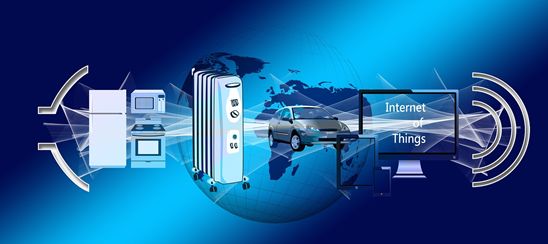
LoRa (Long Range) is a long-range wireless transmission solution based on spread spectrum technology, adopted and promoted by the American company Semtech. Its communication transmission is similar to Wi-Fi, allowing multiple devices to form a local area network over short distances.
The LoRa IoT mainly consists of four parts: terminals (which can have built-in LoRa modules), gateways (or base stations), servers, and the cloud. Because the LoRa network is a private protocol, setting up a LoRa network requires separate construction and has a high initial investment.
On the other hand, NB-IoT technology is a globally standardized solution established by international telecom operators, allowing NB-IoT devices to directly use existing telecom operators’ base stations for networking.
Since it shares the telecom operators’ communication solutions, with the arrival of the 5G era, NB-IoT devices can also directly connect to 5G networks through protocol upgrades. Therefore, compared to LoRa, IoT chip devices under NB-IoT technology can truly form a global IoT system.
Understanding this fact allows us to answer the question of why there was no Internet of Things in the 4G era.
According to Wikipedia:
Discussions about smart connected devices date back to 1982, but it wasn’t until 1995 that Bill Gates first mentioned the definition of the Internet of Things (device-to-device) in his published book “The Road Ahead.”
In 1998, MIT proposed the concept of the Internet of Things, then known as the EPC system.
In 1999, Auto-ID Labs officially proposed the English name for the Internet of Things based on item coding technology.
In the following years, although the International Telecommunication Union pointed out the arrival of the “Internet of Things” era in the report “ITU Internet Report 2005” released at the World Information Summit on November 17, 2005, the development of IoT technology did not truly start until 2009.
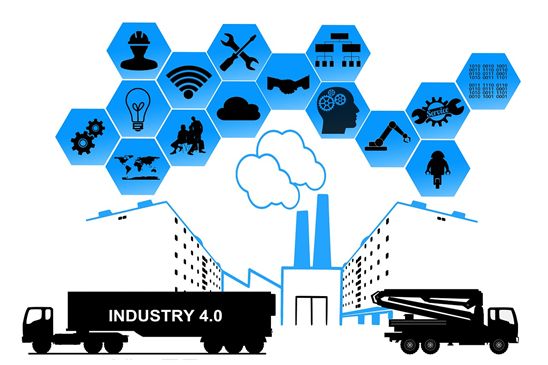
The establishment of the starting line in 2009 was due to the birth of LoRa technology in a French company.
However, the initial prospects of LoRa technology were not recognized by this French company, so it wasn’t until 2012 that the American company Semtech discovered this technology and rescued the LoRa patent from the French company for $5 million.
To develop the prospects of LoRa’s patent, Semtech has been vigorously promoting this technology at various conferences for the next three years.
As the LoRa IoT solution attracted more industry giants, Semtech invited influential companies like IBM to establish the LoRa Alliance in February 2015, unifying the design standards for LoRa IoT chips for the first time.
At this time, another mainstream IoT technology, NB-IoT, was just emerging under the promotion of communication leaders Huawei and Qualcomm.
In May 2014, Huawei and Qualcomm proposed the narrowband technology NB M2M; in May 2015, it merged with NB OFDMA to form NB-CIoT; in July, NB-LTE further merged with NB-CIoT to form today’s NB-IoT.
Therefore, for the construction of the Internet of Things, although the concept appeared early, reliable technology for the Internet of Things did not emerge until 2009, and commercialization only began in 2015.
Moreover, in 2015, due to the immaturity of NB-IoT technology, even if IoT construction was carried out, it was mostly unrelated to the IoT ecosystem under 5G networks.
In 2019, as the fourth year since the birth of NB-IoT technology, neither the chip production capacity of NB-IoT nor the current 4G network could meet the demands of cloud computing and artificial intelligence for millisecond-level response speeds in the Internet of Things.
Therefore, compared to the commercial progress of LoRa IoT, to experience the ideal smart IoT, we can only wait for the 5G network to mature enough, along with the progress of NB-IoT technology.
And all of this still requires time.

The Current State of 5G IoT Chip Industry
Because NB-IoT technology is a global public standard, the internal competition and struggles in this global public domain are far more than the competitors of LoRa technology under private protocols.
According to data from the LPWAN industry alliance in 2018:
Currently, there are over 20 manufacturers participating in the construction of 5G IoT chips and modules globally. Among them, there are 18 manufacturers of NB-IoT chip sources and 23 manufacturers of NB-IoT modules.
Among these manufacturers, those with mature commercialization capabilities are mainly represented by communication companies with 5G network patents, such as Qualcomm, Huawei, MediaTek, and Intel.
Their specific list is as follows:
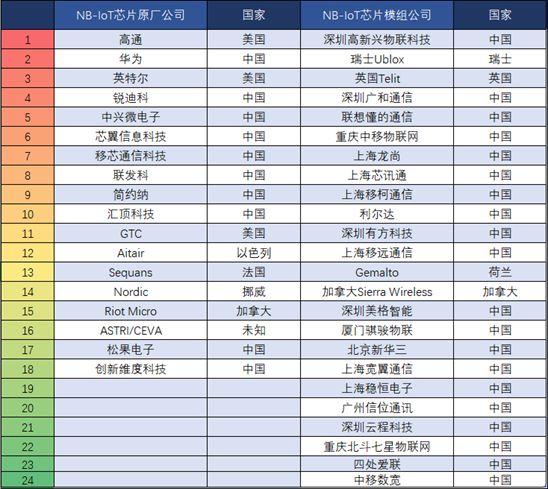
It is worth noting that in the current construction of 5G IoT, although all manufacturers are betting on NB-IoT technology, most of the current NB-IoT chips do not support 5G networks due to the incomplete coverage of 5G networks, and are more focused on 2G, 3G, and 4G networks.
Among them, Huawei’s Boudica series NB-IoT chips achieved large-scale shipment in June 2017, and this chip is manufactured by TSMC, with NB-IoT commercial modules provided by ublox and Quectel.
Qualcomm, also a proponent of NB-IoT technology, achieved mass production of the MDM9206 series in May 2018.
Because Huawei holds more patents in NB-IoT technology, and the NB-IoT chips of the 4G era were unstable in signal transmission and had more latency, Qualcomm chose to support a multi-mode mode of eMTC/NB-IoT/GSM on the MDM9206 series chips.
In fact, for NB-IoT chips to support 5G networks, several technical consensus transitions are still needed. For example, once the 5G communication standards are fully established, global telecom operators need to discuss the allocation of communication frequency bands, revenue, and technical common standards for NB-IoT devices.
Therefore, at this stage, Qualcomm’s multi-mode multi-frequency chips are more in line with market demand than single-network NB-IoT chips.
According to Wikipedia, under 4G networks, multi-mode NB-IoT devices supporting eMTC can achieve uplink and downlink rates of 1 Mbps, while single-mode NB-IoT devices have a downlink rate of only 20 kbps and an uplink rate of only 60 kbps.
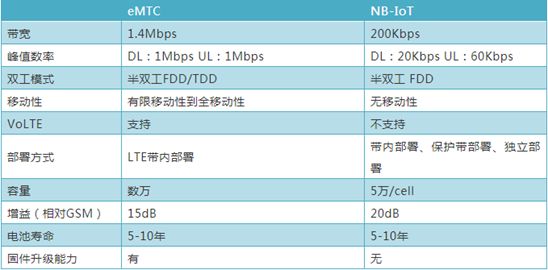
The table is from Global IoT Observation.
Therefore, IoT chips from companies like Intel, Nordic, Altair, and Sequans have chosen to support both NB-IoT and LTE-M. Among domestic companies, module manufacturers such as Ruideke, ZTE IoT, Yike Communication, Xinxun Communication, and Longshang Technology have all based their NB-IoT modules on Qualcomm’s MDM9206, standing in the multi-mode camp.
According to industry insiders, without the millisecond-level response speed of 5G networks, the current usage scenarios of single-mode NB-IoT chips are more about competing for market space with LoRa chips. However, the more expensive NB-IoT chips currently do not match the cost-effectiveness of LoRa chips in local IoT layouts.
This phenomenon leaves room for potential dark horses to emerge in the future of 5G IoT chip technology.

Who Will Be the Winner of the IoT in the 5G Era?
To answer this question, we still need to analyze it from the perspective of 5G IoT chip technology.
Currently, the IoT chips related to 5G mainly focus on NB-IoT technology, and since NB-IoT devices need to connect to telecom operators’ base stations and networks, every IoT device equipped with an NB-IoT chip will need to use the telecom operators’ data services in the future.
Therefore, at the beginning of NB-IoT technology’s birth, major global telecom operators provided their own subsidy plans for the production of NB-IoT chips.
Among them, media reports in 2018 indicated that China Telecom hoped to stimulate the maturity of NB-IoT modules with a subsidy of 300 million yuan, while China Mobile offered a subsidy rate of up to 50% for NB-IoT modules.
Although telecom operators have provided substantial subsidies, the price of NB-IoT chips remains high due to the scale of the NB-IoT module industry.
From the module manufacturers’ quotes, due to different configurations, the prices of NB-IoT modules in 2018 were mostly concentrated at the level of 40-50 yuan. In contrast, the price of 2G modules with the same transmission speed efficiency has already fallen below 20 yuan.
Therefore, when downstream manufacturers choose to purchase, they still mainly opt for 2G module IoT chips, and the promotion of NB-IoT devices is not going smoothly. However, in response to this phenomenon, Huawei’s Wang Qiang stated that the price of the Boudica 150 shipped in the second quarter of 2018 had decreased by 50% compared to the previous year, with an overall decrease of 2-3 dollars, and the trend of price reduction is accelerating.
Huawei’s aggressive approach to NB-IoT single-mode devices clearly shows confidence in bringing NB-IoT modules into the 5G IoT era with competitive pricing and high quality.
In fact, due to the current cost-effectiveness disadvantage of NB-IoT modules in the market, manufacturers producing NB-IoT modules are not making much profit. However, with the efforts of major international telecom operators and technology giants, the manufacturers of NB-IoT modules and chip foundries will become the first beneficiaries of this multi-billion-dollar IoT chip market.
According to historical news, the number of operators supporting NB-IoT networks has increased from 21 in December 2017 to 60 in August 2018, which strengthens our verification of the above trend.
When the market for NB-IoT chips becomes saturated, since the main series of IoT chips from Huawei and Qualcomm have a design life of over ten years, the hundreds of billions of IoT devices globally will allow telecom operators to charge for network services based on the use of 5G network NB-IoT devices.
In 2018, China Telecom and China Mobile provided pricing information for NB-IoT devices, with China Telecom’s annual package price set at 20 yuan per household, while China Mobile offered two price options of 20 yuan and 40 yuan for annual services.
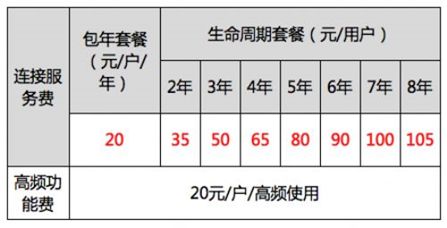
China Telecom’s pricing plan in 2018.
However, it is worth noting that the current speed of NB-IoT devices is extremely slow, so when 5G arrives, the current pricing situation does not have practical reference value. However, the annual price of NB-IoT devices will likely be referenced against the monthly package of 5G network fees.
Thus, for this 5G IoT initiative spanning over a decade, we can be certain that: winners will emerge in stages.
Initially, companies producing chips and modules will lead, followed by telecom operators in the mid-term, and ultimately, whoever can control the discourse power of cloud computing, artificial intelligence, and big data will be the true winner of this revolution.
All we can do now is wait for good news.
Recent Selections
A lengthy article interpreting operators’ battles in 5G
A lengthy report shorting Tesla
We cannot kill Samsung